Predator theme by opy01
Download: Predator.p3t
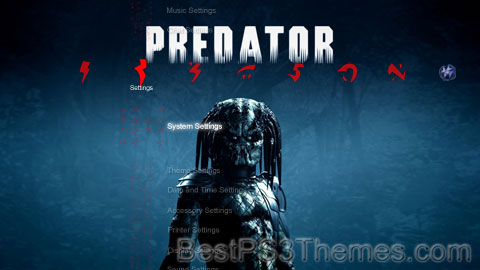
(1 background)
Redirect to:
This page is a redirect. The following categories are used to track and monitor this redirect:
|

The #1 spot for Playstation themes!
Predator theme by opy01
Download: Predator.p3t

(1 background)
Redirect to:
This page is a redirect. The following categories are used to track and monitor this redirect:
|
The Many Faces Of The Joker theme by ZHero
Download: ManyFacesOfTheJoker.p3t

(9 backgrounds)
P3T Unpacker v0.12
Copyright (c) 2007. Anoop Menon
This program unpacks Playstation 3 Theme files (.p3t) so that you can touch-up an existing theme to your likings or use a certain wallpaper from it (as many themes have multiple). But remember, if you use content from another theme and release it, be sure to give credit!
Download for Windows: p3textractor.zip
Instructions:
Download p3textractor.zip from above. Extract the files to a folder with a program such as WinZip or WinRAR. Now there are multiple ways to extract the theme.
The first way is to simply open the p3t file with p3textractor.exe. If you don’t know how to do this, right click the p3t file and select Open With. Alternatively, open the p3t file and it will ask you to select a program to open with. Click Browse and find p3textractor.exe from where you previously extracted it to. It will open CMD and extract the theme to extracted.[filename]. After that, all you need to do for any future p3t files is open them and it will extract.
The second way is very simple. Just drag the p3t file to p3textractor.exe. It will open CMD and extract the theme to extracted.[filename].
For the third way, first put the p3t file you want to extract into the same folder as p3textractor.exe. Open CMD and browse to the folder with p3extractor.exe. Enter the following:
p3textractor filename.p3t [destination path]Replace filename with the name of the p3t file, and replace [destination path] with the name of the folder you want the files to be extracted to. A destination path is not required. By default it will extract to extracted.filename.
Raven from Teen Titans (SD) theme by Raven_Freak
Download: RavenfromTeenTitansSD.p3t
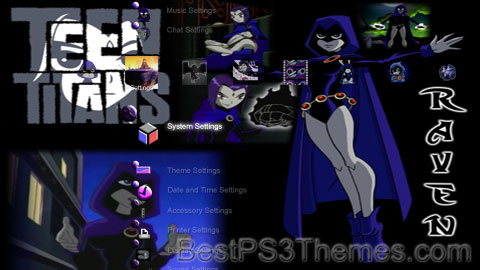
(6 backgrounds)
P3T Unpacker v0.12
Copyright (c) 2007. Anoop Menon
This program unpacks Playstation 3 Theme files (.p3t) so that you can touch-up an existing theme to your likings or use a certain wallpaper from it (as many themes have multiple). But remember, if you use content from another theme and release it, be sure to give credit!
Download for Windows: p3textractor.zip
Instructions:
Download p3textractor.zip from above. Extract the files to a folder with a program such as WinZip or WinRAR. Now there are multiple ways to extract the theme.
The first way is to simply open the p3t file with p3textractor.exe. If you don’t know how to do this, right click the p3t file and select Open With. Alternatively, open the p3t file and it will ask you to select a program to open with. Click Browse and find p3textractor.exe from where you previously extracted it to. It will open CMD and extract the theme to extracted.[filename]. After that, all you need to do for any future p3t files is open them and it will extract.
The second way is very simple. Just drag the p3t file to p3textractor.exe. It will open CMD and extract the theme to extracted.[filename].
For the third way, first put the p3t file you want to extract into the same folder as p3textractor.exe. Open CMD and browse to the folder with p3extractor.exe. Enter the following:
p3textractor filename.p3t [destination path]Replace filename with the name of the p3t file, and replace [destination path] with the name of the folder you want the files to be extracted to. A destination path is not required. By default it will extract to extracted.filename.
Naruto theme by Rasenki
Download: Naruto_6.p3t
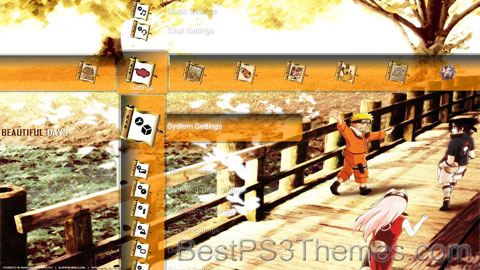
(4 backgrounds)
| Naruto | |
 First tankōbon volume cover, featuring Naruto Uzumaki | |
| NARUTO | |
|---|---|
| Genre | |
| Manga | |
| Written by | Masashi Kishimoto |
| Published by | Shueisha |
| English publisher | |
| Imprint | Jump Comics |
| Magazine | Weekly Shōnen Jump |
| English magazine | |
| Demographic | Shōnen |
| Original run | September 21, 1999 – November 10, 2014 |
| Volumes | 72 |
| Anime television series | |
| |
| Media franchise | |
Naruto[a] is a Japanese manga series written and illustrated by Masashi Kishimoto. It tells the story of Naruto Uzumaki, a young ninja who seeks recognition from his peers and dreams of becoming the Hokage, the leader of his village. The story is told in two parts: the first is set in Naruto's pre-teen years (volumes 1–27), and the second in his teens (volumes 28–72). The series is based on two one-shot manga by Kishimoto: Karakuri (1995), which earned Kishimoto an honorable mention in Shueisha's monthly Hop Step Award the following year, and Naruto (1997).
Naruto was serialized in Shueisha's shōnen manga magazine Weekly Shōnen Jump from September 1999 to November 2014, with its chapters collected in 72 tankōbon volumes. Viz Media licensed the manga for North American production and serialized Naruto in their digital Weekly Shonen Jump magazine. Part I of the manga was adapted into an anime television series by Pierrot and Aniplex, which ran for 220 episodes from October 2002 to February 2007 on TV Tokyo. A second series, which adapts material from Part II of the manga, is titled Naruto: Shippuden and ran on TV Tokyo for 500 episodes from February 2007 to March 2017. Pierrot also developed 11 animated films and 12 original video animations (OVAs). The franchise includes light novels, video games, and trading cards developed by several companies. The story of Naruto continues in Boruto, where Naruto's son Boruto Uzumaki creates his own ninja way instead of following his father's.
Naruto is one of the best-selling manga series of all time, having 250 million copies in circulation worldwide in 47 countries and regions, with 153 million copies in Japan alone and remaining 97 million copies elsewhere. It has become one of Viz Media's best-selling manga series; their English translations of the volumes have appeared on USA Today and The New York Times bestseller list several times, and the seventh volume won a Quill Award in 2006. Reviewers praised the manga's character development, storylines, and action sequences, though some felt the latter slowed the story down. Critics noted that the manga, which has a coming-of-age theme, makes use of cultural references from Japanese mythology and Confucianism.
A powerful fox known as the Nine-Tails attacks Konoha, the hidden leaf village in the Land of Fire, one of the Five Great Shinobi Countries in the Ninja World. In response, the leader of Konoha and the Fourth Hokage, Minato Namikaze, at the cost of his life, seals the fox inside the body of his newborn son, Naruto Uzumaki, making him a host of the beast.[i] The Third Hokage returns from retirement to become the leader of Konoha again. Naruto is often scorned by Konoha's villagers for being the host of the Nine-Tails. Due to a decree by the Third Hokage forbidding any mention of these events, Naruto learns nothing about the Nine-Tails until 12 years later, when Mizuki, a renegade ninja, reveals the truth to him. Naruto defeats Mizuki in combat, earning the respect of his teacher, Iruka Umino.[ii]
Shortly afterward, Naruto becomes a ninja and joins with Sasuke Uchiha, against whom he often competes, and Sakura Haruno, on whom he has a crush, to form Team 7, under an experienced sensei, the elite ninja Kakashi Hatake. Like all the ninja teams from every village, Team 7 completes missions requested by the villagers, ranging from doing chores and being bodyguards to performing assassinations.
After several missions, including a major one in the Land of Waves, Kakashi allows Team 7 to take a ninja exam, enabling them to advance to a higher rank and take on more difficult missions, known as Chunin Exams. During the exams, Orochimaru, a wanted criminal, invades Konoha and kills the Third Hokage for revenge. Jiraiya, one of the three legendary ninjas, declines the title of Fifth Hokage and searches with Naruto for Tsunade whom he chooses to become Fifth Hokage instead.
During the search, it is revealed that Orochimaru wishes to train Sasuke because of his powerful genetic heritage, the Sharingan.[iii] After Sasuke attempts and fails to kill his older brother Itachi,[iv] who had showed up in Konoha to kidnap Naruto, he joins Orochimaru, hoping to gain from him the strength needed to kill Itachi. The story takes a turn when Sasuke leaves the village: Tsunade sends a group of ninja, including Naruto, to retrieve Sasuke, but Naruto is unable to persuade or force him to come back. Naruto and Sakura do not give up on Sasuke; Naruto leaves Konoha to receive training from Jiraiya to prepare himself for the next time he encounters Sasuke, while Sakura becomes Tsunade's apprentice.
Two and a half years later, Naruto returns from his training with Jiraiya. The Akatsuki starts kidnapping the hosts of the powerful Tailed Beasts. Team 7 and other Leaf ninja fight against them and search for their teammate Sasuke. The Akatsuki succeeds in capturing and extracting seven of the Tailed Beasts, killing all the hosts except Gaara, who is now the Kazekage. Meanwhile, Sasuke betrays Orochimaru and faces Itachi to take revenge. After Itachi dies in battle, Sasuke learns from the Akatsuki founder Tobi that Itachi had been ordered by Konoha's superiors to destroy his clan to prevent a coup; he accepted, on the condition that Sasuke would be spared. Devastated by this revelation, Sasuke joins the Akatsuki to destroy Konoha in revenge. As Konoha ninjas defeat several Akatsuki members, the Akatsuki figurehead leader, Nagato, kills Jiraiya and devastates Konoha, but Naruto defeats and redeems him, earning the village's respect and admiration.
With Nagato's death, Tobi, disguised as Madara Uchiha (one of Konoha's founding fathers), announces that he wants to capture all nine Tailed Beasts to cast an illusion powerful enough to control all humanity and achieve world peace. The leaders of the five ninja villages refuse to help him and instead join forces to confront his faction and allies. That decision results in a Fourth Shinobi World War between the combined armies of the Five Great Countries (known as the Allied Shinobi Forces) and Akatsuki's forces of zombie-like ninjas. The Five Kage try to keep Naruto, unaware of the war, in a secret island turtle near Kumogakure (Hidden Cloud Village), but Naruto finds out and escapes from the island with Killer Bee, the host of the Eight-Tails. At that time, Naruto—along with the help of Killer Bee—gains control of his Tailed Beast and the two of them head for the battlefield.
During the conflict, it is revealed that Tobi is Obito Uchiha, a former teammate of Kakashi's who was thought to be dead. The real Madara saved Obito's life, and they have since collaborated. As Sasuke learns the history of Konoha, including the circumstances that led to his clan's downfall, he decides to protect the village and rejoins Naruto and Sakura to thwart Madara and Obito's plans. However, Madara's body ends up possessed by Kaguya Otsutsuki, an ancient princess who intends to subdue all humanity. A reformed Obito sacrifices himself to help Team 7 stop her. Once Kaguya is sealed, Madara dies as well. Sasuke takes advantage of the situation and takes control of all the Tailed Beasts, as he reveals his goal of ending the current village system. Naruto confronts Sasuke to dissuade him from his plan, and after they almost kill each other in a final battle, Sasuke admits defeat and reforms. After the war, Kakashi becomes the Sixth Hokage and pardons Sasuke for his crimes. Years later, Kakashi steps down while Naruto marries Hinata Hyuga and becomes the Seventh Hokage, raising the next generation.
In 1995, Shueisha released Karakuri, a one-shot manga by Masashi Kishimoto that earned an honorable mention in the Hop Step Award in 1996. Kishimoto was unsatisfied with his subsequent drafts for a follow-up, and decided to work on another project.[2] The new project was originally going to feature Naruto as a chef, but this version never made it to print. Kishimoto originally wanted to make Naruto a child who could transform into a fox, so he created a one-shot of Naruto for the summer 1997 issue of Akamaru Jump based on the idea.[3][4] Despite the positive feedback it received in a readers' poll, Kishimoto was unhappy with the art and the story, so he rewrote it as a story about ninjas.[5]
The first eight chapters of Naruto were planned before it appeared in Weekly Shōnen Jump, and these chapters originally devoted many panels of intricate art to illustrating the Konoha village. By the time Naruto debuted, the background art was sparse, instead emphasizing the characters.[5] Though Kishimoto had concerns that chakra (the energy source used by the ninjas in Naruto) made the series too Japanese, he still believed it is an enjoyable read.[6] Kishimoto is a fan of Godzilla, and the tailed beasts mythology was introduced because Kishimoto wanted an excuse to draw monsters.[7] He has said that the central theme in Part I of Naruto is how people accept each other, citing Naruto's development across the series as an example.[8]
For Part II of the manga, Kishimoto tried to keep the panel layouts and the plot easy for the reader to follow, and avoid "overdo[ing] the typical manga-style".[9] He considers that his drawing style has changed from "the classic manga look to something a bit more realistic."[9] Because of wishing to end the arc involving Sasuke Uchiha's search for his brother, Itachi, in a single volume, Kishimoto decided that volume 43 should include more chapters than regular volumes. As a result, Kishimoto apologized to readers for this since volume 43 was more expensive than regular volumes.[10]
When he created Naruto, Kishimoto looked to other shōnen manga as influences for his work and tried to make his characters unique, while basing the story on Japanese culture.[11] The separation of the characters into different teams was intended to give each group a particular flavor. Kishimoto wanted each member to have a high level of aptitude in one skill and be talentless in another.[12] He found it difficult to write about romance, but emphasized it more in Part II of the manga, beginning with volume 28.[8] He introduced villains into the story to have them act as a counterpoint to his characters' moral values and clearly illustrate their differences.[13] As a result of how the younger characters were significantly weaker than the villains, Kishimoto made the ellipsis in order to have them age and become stronger during this time.[14]
Kishimoto made use of the Chinese zodiac tradition, which had a long-standing presence in Japan; the zodiac hand signs originate from this.[6] When Kishimoto was creating the primary setting of the Naruto manga, he concentrated initially on the designs for the village of Konoha. The idea of the setting came to him "pretty spontaneously without much thought", but admits that the scenery became based on his home in the Japanese prefecture of Okayama. Since the storyline does not specify when it is set, he was able to include modern elements in the series such as convenience stores.[15] He considered including automobiles, planes and simple computers, but excluded projectile weapons and vehicles from the plot.[15][16]
Masashi Kishimoto's home was close to Hiroshima where his grandfather lived. He would often tell his grandson stories of war and how it was related to grudges. In retrospect, Kishimoto commented he could not criticize anyone as a result of the war based on it was built.[clarification needed] Upon further researching, Kishimoto decided to create world war story arc for the manga's finale. However, unlike the stories he heard from his grandfather, Kishimoto wanted to give the war covered in Naruto a more hopeful feeling.[17] Nagato's arc paved the way for the ending of Naruto to occur. Nagato stood out as a villain due to suffering war and killing Naruto's mentor Jiraiya. Understanding the fears of war, Naruto's characterization was made more complex for him to experience the Fourth Great Shinobi War. These events end with Naruto forgiving Sasuke as he had forgiven Nagato in the final battle.[14]
Due to unknown issues, the series' finale was delayed. Once volume 66 was released, Kishimoto commented he reached a moment from the narrative involving something he always wanted to draw.[18] When serialization began, Kishimoto decided the ending would feature a fight between two characters: Naruto and Sasuke. However, the writer felt the two were not equals as the former was not a victim of war like the latter whose family was killed to stop a possible civil war.[19]
Kishimoto chose Hinata Hyuga as Naruto's romantic partner from the early stages of the manga, since Hinata had always respected and admired Naruto even before the series' beginning, and Kishimoto felt this meant the two of them could build a relationship.[20] When Hinata first appeared, Kishimoto thought of expanding romantic plotlines.[21][22] but decided to leave Naruto's maturation through romance as an idea for the film 2014 The Last: Naruto the Movie where he worked alongside screenwriter Maruo Kyozuka, a writer more skilled at the theme of romance.[23] Similarly, the title character's relationship with his first son, Boruto, was explored furthermore in the 2015 film Boruto: Naruto the Movie to end Naruto's growth as the character had become an adult, but it was briefly shown in the manga's finale.[24]
Written and illustrated by Masashi Kishimoto, Naruto was serialized for a 15-year run in Shueisha's magazine, Weekly Shōnen Jump from September 21, 1999,[25][26] to November 10, 2014.[27][28] Shueisha collected its chapters in 72 tankōbon volumes—27 for Part I, and the rest for Part II; they were released between March 3, 2000,[29] and February 4, 2015.[30] The first 238 chapters are Part I and constitute the first section of the Naruto storyline. Chapters 239 to 244 include a gaiden (side-story) focusing on Kakashi Hatake's background. The remaining chapters (245 to 700) belong to Part II, which continues the story after a 2+1⁄2-year gap in the internal timeline. Shueisha have also released several ani-manga tankōbon, each based on one of the Naruto movies,[31] and has released the series in Japanese for cell-phone download on their website Shueisha Manga Capsule.[32] A miniseries titled Naruto: The Seventh Hokage and the Scarlet Spring,[b] centered on the main characters' children, began serialization in the Japanese and English editions of Weekly Shōnen Jump on April 27, 2015, and ended after ten chapters on July 6 of the same year.[33][34]
Naruto was scanlated (translated by fans) and available online before a licensed version was released in North America;[35] the rights were acquired by Viz Media, who began serializing Naruto in their anthology comic magazine Shonen Jump, starting with the January 2003 issue.[36] The schedule was accelerated at the end of 2007 to catch up with the Japanese version,[37] and again in early 2009, with 11 volumes (from 34 to 44) appearing in three months, after which it returned to a quarterly schedule.[38] All 27 volumes of Part I were released in a boxed set on November 13, 2007.[39] On May 3, 2011, Viz started selling the manga in an omnibus format with each book containing three volumes.[40]
The franchise has been licensed in 90 countries, and the manga serialized in 35 countries.[41][42] Madman Entertainment began publishing Naruto volumes in Australia and New Zealand in March 2008 after reaching a distribution deal with Viz Media.[43] Carlsen Comics has licensed the series, through its regional divisions, and released the series in German and Danish.[44] The series is also licensed for regional language releases in French and Dutch by Kana,[45] in Polish by Japonica Polonica Fantastica,[46] in Russian by Comix-ART,[47] in Finnish by Sangatsu Manga,[48] in Swedish by Bonnier Carlsen,[49] and Italian by Panini Comics.[50]
A spin-off comedy manga by Kenji Taira, titled Naruto SD: Rock Lee no Seishun Full-Power Ninden,[c] focuses on the character Rock Lee, a character who aspires to be strong as a ninja but has no magical jutsu abilities. It ran in Shueisha's Saikyō Jump magazine from December 3, 2010, to July 4, 2014,[51][52] and was made into an anime series, produced by Studio Pierrot, and premiering on TV Tokyo on April 3, 2012.[53] Crunchyroll simulcasted the series' premiere on their website and streamed the following episodes.[54] Taira also wrote Uchiha Sasuke no Sharingan Den,[d] which released on October 3, 2014, which runs in the same magazine and features Sasuke.[55]
A monthly sequel series titled Boruto: Naruto Next Generations began in the Japanese and English editions of Weekly Shōnen Jump in early 2016, illustrated by Mikio Ikemoto and written by Ukyō Kodachi, with supervision by Kishimoto. Ikemoto was Kishimoto's chief assistant during the run of the original Naruto series, and Kodachi was his writing partner for the Boruto: Naruto the Movie film screenplay. The monthly series was preceded by a one-shot, titled Naruto: The Path Lit by the Full Moon (NARUTO-ナルト-外伝 ~満ちた月が照らす道~, Naruto Gaiden ~Michita Tsuki ga Terasu Michi~), written and illustrated by Kishimoto, and published on April 25 of that same year.[56][57][58] The staff from Shueisha asked Kishimoto if he would write a sequel to Naruto. However, Kishimoto refused the offer and offered his former assistant Mikio Ikemoto and writer Ukyō Kodachi write Boruto: Naruto Next Generations as the sequel to Naruto.[59]
Another one-shot chapter by Kishimoto, titled Naruto: The Whorl Within the Spiral (NARUTO-ナルト-外伝 ~渦の中のつむじ風~, Naruto Gaiden ~Uzu no Naka no Tsumujikaze~), centered on Naruto's father, Minato Namikaze, was published in Weekly Shōnen Jump on July 18, 2023.[60][61]
The first Naruto anime television series, directed by Hayato Date and produced by Pierrot and Aniplex, premiered on TV Tokyo in Japan on October 3, 2002, and concluded on February 8, 2007, after 220 episodes.[62][63] The first 135 episodes were adapted from Part I of the manga; the remaining 85 episodes are original and use plot elements that are not in the manga.[64] Tetsuya Nishio was the character designer for Naruto when the manga was adapted into an anime; Kishimoto had requested that Nishio be given this role.[65][66]
The second anime television series, titled Naruto: Shippuden[e], was also produced by Pierrot and directed by Hayato Date, and serves as a direct sequel to the first Naruto anime series; it corresponds to Part II of the manga.[67] It debuted on Japanese TV on February 15, 2007, on TV Tokyo, and concluded on March 23, 2017.[68][69]
A series of four "brand-new" episodes, to commemorate the original anime's 20th anniversary, were originally scheduled to premiere on September 3, 2023;[70] however, in August of that same year, it was announced that the episodes would be postponed to a later date.[71]
The series was adapted into 11 theatrical films and 12 original video animations (OVAs). The first three films correspond to the first series, and the remaining eight correspond to the second. In July 2015, Lionsgate announced the development of a live-action film with Avi Arad through his production company Arad Productions.[72] The film will be directed by Michael Gracey. On December 17, 2016, Kishimoto announced that he has been asked to co-develop.[73] On November 27, 2023, it was announced that Tasha Huo will work on the script for the film.[74]
On February 23, 2024, Gracey had exited the project, and Destin Daniel Cretton had been hired to direct and co-write the film. Cretton received his blessings from Kishimoto, after a visit in Tokyo, with Kishimoto stating that when he heard that Cretton would be directing, he thought that he was the perfect choice.[75]
Twenty-six Naruto light novels, the first nine written by Masatoshi Kusakabe, have been published in Japan.[76] Of these, the first two have been released in English in North America. The first adapted novel, Naruto: Innocent Heart, Demonic Blood (2002), retells a Team 7 mission in which they encounter the assassins Zabuza and Haku;[77][78] the second, Naruto: Mission: Protect the Waterfall Village! (2003) was based on the second OVA of the anime.[79][80] Viz has also published 16 chapter books written by Tracey West with illustrations from the manga. Unlike the series, these books were aimed at children ages seven to ten.[81] Thirteen original novels have appeared in Japan;[76] eleven of these are part of a series, and the other two are independent novels unconnected to the series. The first independent novel, titled Naruto: Tales of a Gutsy Ninja (2009), is presented as an in-universe novel written by Naruto's master Jiraiya. It follows the adventures of a fictional shinobi named Naruto Musasabi, who served as Naruto's namesake.[82] The other independent novel, Naruto Jinraiden: The Day the Wolf Howled (2012), is set shortly after Sasuke's fight with Itachi.[83]
Itachi Shinden, which consists of two novels, and Sasuke Shinden, a single novel, both appeared in 2015, and both were adapted into anime arcs in Naruto: Shippuden in 2016, titled Naruto Shippūden: Itachi Shinden-hen: Hikari to Yami and Book of Sunrise respectively.[84][85] Hiden is a series of six light novels published in 2015 that explores the stories of various characters after the ending of the manga.[86]
Naruto video games have been released on various consoles by Nintendo, Sony, and Microsoft. The majority of them are fighting games in which the player directly controls one of the characters from Naruto. The player pits their character against another character controlled by the game's
The Joker theme by Snowlegend Download: Joker_3.p3t Redirect to: Buffy the Vampire Slayer theme by hippie_boy Download: BuffytheVampireSlayer.p3t
Buffy the Vampire Slayer is an American supernatural drama television series created by writer and director Joss Whedon. The concept is based on the 1992 film, also written by Whedon, although they are separate and unrelated productions.[12] Whedon served as executive producer and showrunner of the series under his production tag Mutant Enemy Productions. It premiered on March 10, 1997, on The WB and concluded on May 20, 2003, on UPN.
The series follows Buffy Summers (played by Sarah Michelle Gellar), the latest in a succession of young women known as "Vampire Slayers", or simply "Slayers". Slayers are chosen by fate to battle against vampires, demons and other forces of darkness. Buffy wants to live a normal life, but learns to embrace her destiny as the series progresses. Like previous Slayers, Buffy is aided by a Watcher, who guides, teaches and trains her. Unlike her predecessors, she surrounds herself with loyal friends who become known as the "Scoobies". The show primarily takes place in the fictional setting of Sunnydale, a small Southern California city that is located on a "Hellmouth"; a portal "between this reality and the next," and a convergence point of mystical energies.[13] Because of this, supernatural creatures and beings with magical powers, both good and evil, are drawn to Sunnydale, or rise from below ground to menace the town and the world.
The series received critical and popular acclaim, and is often listed among the greatest television series of all time. Original airings often reached four to six million viewers.[14][15] Although lower than successful shows on the "big four" networks (ABC, CBS, NBC and Fox),[16] these ratings were a success for the relatively new and smaller WB Television Network.[17] Despite being mostly ignored by major award programs like the Emmys, the series was nominated for the American Film Institute Award for Drama Series of the Year, Gellar was nominated for the Golden Globe Award for Best Actress – Television Series Drama for her performance in the show and the series was nominated five times for Television Critics Association Awards, winning once in 2003 for the Television Critics Association Heritage Award.
The success of Buffy has led to hundreds of tie-in products, including novels, comics and video games. The series has received attention in fandom (including fan films), parody, and academia, and has influenced the direction of other television series.[1][18] Buffy was part of a wave of television series from the late 1990s and early 2000s that featured strong female characters, alongside Charmed, Xena: Warrior Princess, La Femme Nikita, Dark Angel, and Alias.[19] The series, as well as its spin-off series, Angel, and extensions thereof, have been collectively termed the "Buffyverse".
Buffy Summers (played by Sarah Michelle Gellar) is the "Slayer", one in a long line of young women chosen by fate to battle evil forces. This mystical calling grants her powers that dramatically increase physical strength, endurance, agility, accelerated healing, intuition, and a limited degree of precognition, usually in the form of prophetic dreams. She is known as a reluctant hero who wants to live a normal life. However, she learns to embrace her destiny as the vampire slayer.[20][21]
Buffy receives guidance from her Watcher, Rupert Giles (Anthony Stewart Head). Giles, rarely referred to by his first name (it is later revealed that in his rebellious younger days he went by "Ripper"), is a member of the Watchers' Council, whose job is to train and guide the Slayers. Giles researches the supernatural creatures that Buffy must face, offers insights into their origins, advice on how to defeat them, and helps her train to stay in fighting form.
Buffy also receives help from the friends she meets at Sunnydale High School: Willow Rosenberg (Alyson Hannigan) and Xander Harris (Nicholas Brendon). Willow is originally a wallflower who excels at academics, providing a contrast to Buffy's outgoing personality and less-than-stellar educational record. They share the social isolation that comes with being different, and especially from being exceptional young women. As the series progresses, Willow becomes a more assertive character and a powerful witch, and realizes she is a lesbian. In contrast, Xander, with no supernatural abilities, provides comic relief and a grounded perspective. Buffy and Willow are the only characters who appear in all 144 episodes, with Xander appearing in 143.
The cast of characters grew over the course of the series. Buffy first arrives in Sunnydale with her mother, Joyce Summers (Kristine Sutherland), who functions as an anchor of normality in the Summers' lives even after she learns of Buffy's role in the supernatural world ("Becoming, Part Two"). Buffy's younger sister Dawn Summers (Michelle Trachtenberg) is introduced in season five ("Buffy vs. Dracula"). Angel (David Boreanaz), a vampire cursed with a soul, is Buffy's love interest throughout the first three seasons. He leaves Buffy after realizing he will never be able to give her a normal life. He goes on to make amends for his sins and to search for redemption in his own spin-off television series, Angel. He makes several guest appearances in the remaining seasons, and is present in Buffy's final episode.
At Sunnydale High, Buffy meets several other students besides Willow and Xander willing to join her fight for good, an informal group eventually tagged the "Scooby Gang" or "Scoobies". Cordelia Chase (Charisma Carpenter), the archetypal shallow cheerleader, reluctantly becomes involved. Daniel "Oz" Osbourne (Seth Green), a fellow student, rock guitarist and werewolf, joins the group through his relationship with Willow. Jenny Calendar (Robia LaMorte), Sunnydale's computer science teacher, joins the group after helping destroy a demon trapped in cyberspace during season 1; she later becomes Giles' love interest. Anya (Emma Caulfield) is a former vengeance demon called Anyanka who specialized in avenging scorned women; after losing her powers she became Xander's lover, then joined the Scoobies in season four.
In Buffy's senior year at high school, she meets Faith (Eliza Dushku), another Slayer called forth when Slayer Kendra Young (Bianca Lawson) was killed by vampire Drusilla (Juliet Landau) in season two. Although Faith initially fights on the side of good with Buffy and the rest of the group, she later joins forces with Mayor Richard Wilkins (Harry Groener) after accidentally killing a human. She reappears briefly in the fourth season, looking for vengeance, and moves to Angel where she voluntarily goes to jail for her crimes. Faith reappears in season seven of Buffy, after having helped Angel and his crew, and fights alongside Buffy against the First Evil.
Buffy gathers other allies throughout the series: Spike (James Marsters), a vampire, is an old companion of Angelus (Angel) and one of Buffy's major enemies in early seasons, although he and Buffy later become allies and lovers. At the end of season six, Spike regains his soul. Spike is known for his Billy Idol-style peroxide blond hair and his black leather coat, stolen from a previous Slayer, Nikki Wood. Nikki's son, Robin Wood (D. B. Woodside), joins the group in the final season. Tara Maclay (Amber Benson) is a fellow member of Willow's Wicca group during season four, and their friendship evolves into a romantic relationship. Buffy becomes involved personally and professionally with Riley Finn (Marc Blucas), a military operative in "the Initiative", which hunts demons using science and technology. The final season sees geeky wannabe-villain Andrew Wells (Tom Lenk) side with the Scoobies after initially being their captive/hostage; they regard him more as a nuisance than an ally.
Buffy featured dozens of major and minor recurring characters. For example, the "Big Bad" (villain) characters were featured for at least one season (for example, Glory is a character who appeared in 12 episodes, spanning much of season five). Similarly, characters who allied themselves to the group and characters who attended the same institutions were sometimes featured in multiple episodes.
The show is set in the fictional California town of Sunnydale, whose suburban Sunnydale High School sits on top of a "Hellmouth", a gateway to demon realms. The Hellmouth, located beneath the school library, is a source of mystical energies as well as a nexus for a wide variety of evil creatures and supernatural phenomena. Joss Whedon cited the Hellmouth and "high school as hell" as one of the primary metaphors in creating the series.[22]
Most of Buffy was shot on location in Los Angeles, California. The high school used in the first three seasons is actually Torrance High School, in Torrance, California, the same high school used for Beverly Hills, 90210.[23] The show was initially very dependent on location shooting, because the production budget allowed for few permanent sets to be built.[24] In the first season this was limited to the interior of Sunnydale High (the library, hallways, and classrooms), Buffy's bedroom, and the Master's underground lair. Starting in the second season, more permanent sets were built, including the full interior of Buffy's house, Angel's mansion, and Giles's apartment, as well as extensions to the high school set (the addition of a dining hall and commons area).[24] A driveway area near the gated entrance to Fox Studios was transformed into a graveyard.[24] In the third season the Sunnydale "Main Street" was constructed on the backlot, which would be a staple location for the rest of the series.[25] When the show transitioned to college in the fourth season, the hallway sets from Sunnydale High were remodeled to appear as the interior hallways of UC Sunnydale.[26]
Some of the exterior shots of the college Buffy attends, UC Sunnydale, were filmed at UCLA. Several episodes include shots from the Oviatt Library at CSUN.[27][28] The exterior of the mansion where Angelus, Spike, and Drusilla lived was Frank Lloyd Wright's Ennis House.[29]
Buffy is told in a serialized format, mixing complex, season-long storylines with a villain-of-the-week conflict revolving around Buffy and her friends as they struggle to balance the fight against supernatural evils with their complicated social lives.[30] A typical episode contains one or more villains, or supernatural phenomena, that are thwarted or defeated by the end of the episode. Though elements and relationships are explored and ongoing subplots are included, the show focuses primarily on Buffy and her role as an archetypal heroine. Gellar described the show as "the ultimate metaphor: horrors of adolescence manifesting through these actual monsters. It's the hardest time of life."[31] Each season's storyline is broken down into season-long narratives marked by the rise and defeat of a powerful antagonist, commonly referred to as the "Big Bad".
While the show is mainly a drama with frequent comic relief, most episodes blend different genres, including horror, martial arts, romance, melodrama, farce, fantasy, supernatural, comedy, and, in one episode, musical comedy.
In the first few seasons, the most prominent monsters in the Buffy bestiary are vampires based on traditional myths, lore, and literary conventions. As the series continues, Buffy and her companions fight an increasing variety of demons, as well as ghosts, werewolves, zombies, and unscrupulous humans. They frequently save the world from annihilation by a combination of physical combat, magic, and detective-style investigation, and are guided by an extensive collection of ancient and mystical reference books.
Season one exemplifies the "high school is hell" concept. Buffy Summers has just moved to Sunnydale after burning down her old school's gym and hopes to escape her Slayer duties. Her plans are complicated by Rupert Giles, her new Watcher, who reminds her of the inescapable presence of evil. Sunnydale High is built atop a Hellmouth, a portal to demon dimensions that attracts supernatural phenomena to the area. A mysterious man, Angel, warns Buffy of upcoming danger. She eventually discovers that he is a vampire cursed with a soul, which prevents him from feeding off living humans. Buffy befriends two schoolmates, Xander Harris and Willow Rosenberg, who help her fight evil throughout the series. Buffy, her Watcher and friends later start to collectively call themselves the "Scooby Gang". Their first major threat is the Master, an ancient and especially threatening vampire, who was trapped in the hellmouth underground. When he escapes, Buffy defeats him and saves Sunnydale.
The emotional stakes are raised in season two. Vampire couple Spike and Drusilla come to town. A new slayer, Kendra, who is activated as a result of Buffy's brief death in season one, also arrives in Sunnydale. Popular schoolmate, Cordelia Chase, who resented Buffy and her friends, joins the Scooby Gang and becomes involved with Xander. Willow learns witchcraft and becomes involved with schoolmate Daniel "Oz" Osbourne, who is a werewolf. The romantic relationship between Buffy and the vampire Angel develops. But after they have sex, Angel experiences a moment of true happiness, breaking the gypsy curse that gave him his soul, thus reverting him to a sadistic killer. The evil vampire, famously known as Angelus, joins the other vampires Spike and Drusilla, and he torments Buffy and her friends. He murders multiple innocents and Giles's new girlfriend Jenny Calendar, a gypsy who was sent to maintain Angel's curse. Kendra is murdered by Drusilla. To avert an apocalypse, Buffy is forced to banish Angel to a hell dimension just moments after Willow has restored his soul. The ordeal leaves Buffy emotionally shattered, and she leaves Sunnydale.
After attempting to start a new life in Los Angeles, Buffy returns to town in season three. Angel has been mysteriously released from the demon dimension but is close to insanity due to the torment he suffered there. He recovers, but he and Buffy realize that a relationship between them can never happen and Angel leaves Sunnydale at the end of the season. Giles is fired from the Watchers' Council because he has developed a "father's love" for Buffy and he is replaced by Wesley Wyndam-Pryce. Towards the end of the season, Buffy announces that she will no longer be working for the council. Early in the season, she meets Faith, the Slayer activated after Kendra's death. She also encounters the affable Mayor Richard Wilkins III, who secretly has plans to "ascend" (become a "pure" demon) on Sunnydale High's graduation day. Although Faith initially works well with Buffy, she becomes increasingly unstable after accidentally killing a human and forms a relationship with the paternal yet manipulative mayor. The rivalry between Buffy and Faith eventually lands Faith in a coma. At the end of the season, after the mayor becomes a huge snake-like demon, Buffy, Angel, the Scooby Gang and the entire graduating class destroy him by blowing up Sunnydale High. At the end of the season, Angel and Cordelia leave the series to star in the spin-off series, Angel.
Season four sees Buffy and Willow enroll at UC Sunnydale, while Xander joins the workforce and begins dating Anya, a former vengeance demon. Spike returns as a series regular and is abducted by The Initiative, a top-secret military installation based beneath the UC Sunnydale campus. They implant a microchip in his head that prevents him from harming humans. Every time he tries to harm a human, he suffers excruciating pain. Upon learning that he can still harm other demons, he joins in with the Scooby Gang, purely for the joy of fighting. Oz leaves town after realizing that he is too dangerous as a werewolf, and Willow falls in love with Tara Maclay, another witch. Buffy begins dating Riley Finn, a graduate student and US Army Ranger seconded to The Initiative. Although appearing to be a well-meaning anti-demon operation, The Initiative's sinister plans are revealed when Adam, a monster secretly built from parts of humans, demons and machinery, escapes and begins to wreak havoc on the town. Adam is destroyed by a magical composite of Buffy and her three friends, and The Initiative is shut down.
During season five, a younger sister, Dawn, suddenly appears in Buffy's life; although she is new to the series, to the characters it is as if she has always been there. Buffy is confronted by Glory, an exiled Hell God who is searching for a "Key" that will allow her to return to her Hell dimension and in the process blur the lines between dimensions and unleash Hell on Earth. It is later discovered that the Key's protectors have used Buffy's blood to turn the Key into human form–Dawn–concurrently implanting everybody with lifelong memories of her. The Watchers' Council aids in Buffy's research on Glory, and she and Giles are both reinstated on their own terms. Riley leaves early in the season after realizing that Buffy does not love him and Dark Knight – Why So Serious theme by Kevin Download: DarkKnightWhySoSerious.p3t P3T Unpacker v0.12 This program unpacks Playstation 3 Theme files (.p3t) so that you can touch-up an existing theme to your likings or use a certain wallpaper from it (as many themes have multiple). But remember, if you use content from another theme and release it, be sure to give credit! Download for Windows: p3textractor.zip Instructions: Download p3textractor.zip from above. Extract the files to a folder with a program such as WinZip or WinRAR. Now there are multiple ways to extract the theme. The first way is to simply open the p3t file with p3textractor.exe. If you don’t know how to do this, right click the p3t file and select Open With. Alternatively, open the p3t file and it will ask you to select a program to open with. Click Browse and find p3textractor.exe from where you previously extracted it to. It will open CMD and extract the theme to extracted.[filename]. After that, all you need to do for any future p3t files is open them and it will extract. The second way is very simple. Just drag the p3t file to p3textractor.exe. It will open CMD and extract the theme to extracted.[filename]. For the third way, first put the p3t file you want to extract into the same folder as p3textractor.exe. Open CMD and browse to the folder with p3extractor.exe. Enter the following: James Bond – Quantum of Solace theme by Cacciolam Download: JamesBondQoS.p3t P3T Unpacker v0.12 This program unpacks Playstation 3 Theme files (.p3t) so that you can touch-up an existing theme to your likings or use a certain wallpaper from it (as many themes have multiple). But remember, if you use content from another theme and release it, be sure to give credit! Download for Windows: p3textractor.zip Instructions: Download p3textractor.zip from above. Extract the files to a folder with a program such as WinZip or WinRAR. Now there are multiple ways to extract the theme. The first way is to simply open the p3t file with p3textractor.exe. If you don’t know how to do this, right click the p3t file and select Open With. Alternatively, open the p3t file and it will ask you to select a program to open with. Click Browse and find p3textractor.exe from where you previously extracted it to. It will open CMD and extract the theme to extracted.[filename]. After that, all you need to do for any future p3t files is open them and it will extract. The second way is very simple. Just drag the p3t file to p3textractor.exe. It will open CMD and extract the theme to extracted.[filename]. For the third way, first put the p3t file you want to extract into the same folder as p3textractor.exe. Open CMD and browse to the folder with p3extractor.exe. Enter the following:Dragonball Z #7
The Joker #3
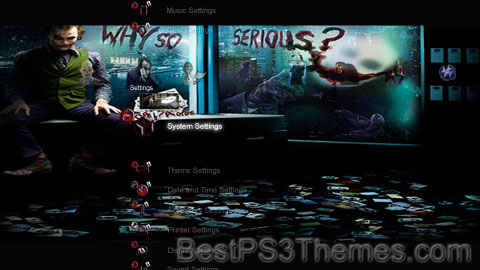
(8 backgrounds)
Buffy the Vampire Slayer

(7 backgrounds)
Buffy the Vampire Slayer 
Genre Created by Joss Whedon Showrunners Starring Theme music composer Nerf Herder Composers Country of origin United States Original language English No. of seasons 7 No. of episodes 144 (list of episodes) Production Executive producers Camera setup Single-camera Running time 42–51 minutes[11] Production companies Original release Network The WB Release March 10, 1997 –
May 22, 2001Network UPN Release October 2, 2001 –
May 20, 2003Related Premise[edit]
Characters[edit]
Setting and filming locations[edit]

Format[edit]
Episodes[edit]
Season Episodes Originally aired First aired Last aired Network 1 12 March 10, 1997 June 2, 1997 The WB 2 22 September 15, 1997 May 19, 1998 3 22 September 29, 1998 September 21, 1999 4 22 October 5, 1999 May 23, 2000 5 22 September 26, 2000 May 22, 2001 6 22 October 2, 2001 May 21, 2002 UPN 7 22 September 24, 2002 May 20, 2003 Plot summary[edit]
Dark Knight – Why So Serious
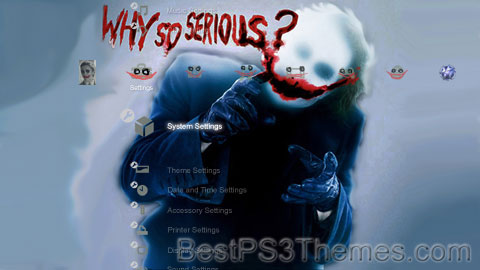
(1 background, HD only)
Copyright (c) 2007. Anoop Menon
p3textractor filename.p3t [destination path]Replace filename with the name of the p3t file, and replace [destination path] with the name of the folder you want the files to be extracted to. A destination path is not required. By default it will extract to extracted.filename.James Bond – Quantum of Solace

(1 background)
Copyright (c) 2007. Anoop Menon
p3textractor filename.p3t [destination path]Replace filename with the name of the p3t file, and replace [destination path] with the name of the folder you want the files to be extracted to. A destination path is not required. By default it will extract to extracted.filename.Punisher War Zone